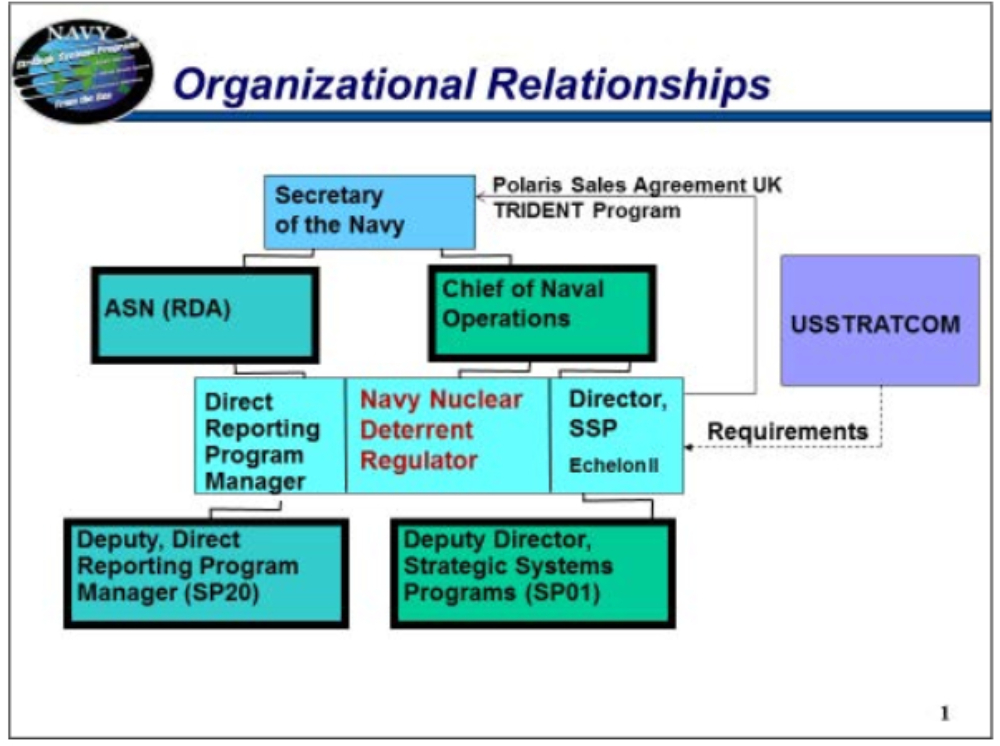
Admiral Padgett, thank you for that introduction. I want to thank the Submarine League for the opportunity to speak here today. I am going to continue my trend that I have done over the last six years while I have been the Director of SSP, and that is I use this as my report card to the community on the obligations and accountability that we have within SSP to ensure that we are properly placed and ready to support the Ohio Replacement Program as she enters into service. Let me start off by reporting something that is relatively new to what we have been doing in SSP and that is the role of the Navy nuclear deterrent regulator.
That responsibility fits nicely between the operations aspects of the program, as well as the acquisition aspects of the program.
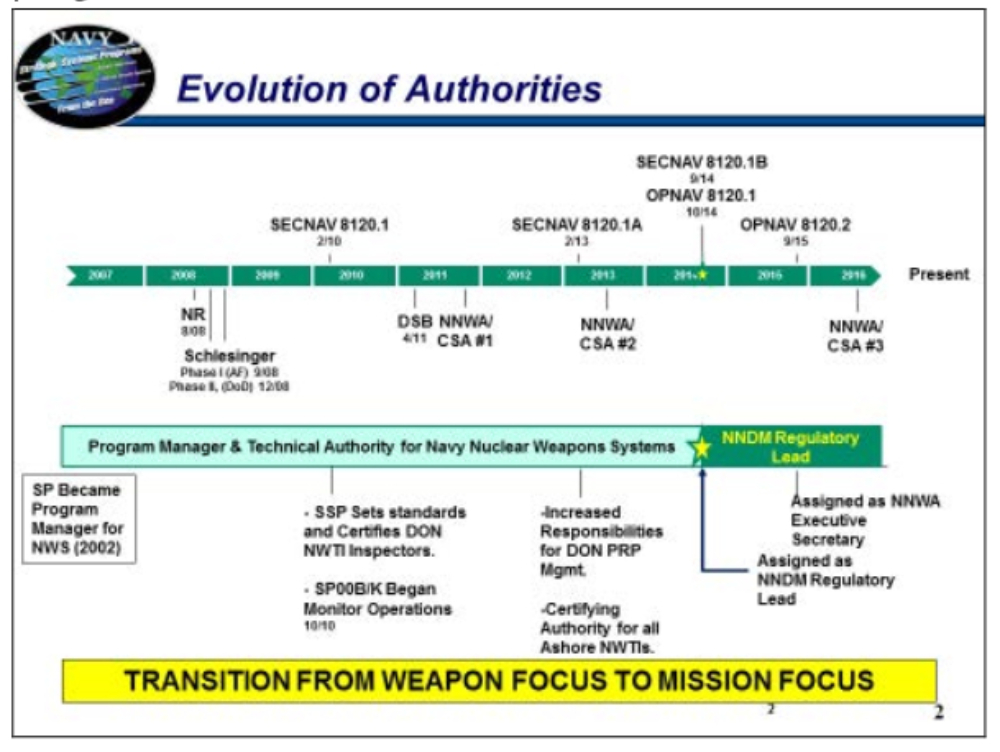
This is an evolution of authorities. In my mind, it goes back to Donald Schlesinger’s review of the Navy’s program after the Air Force incident that flew weapons material from Minot to Barksdale. The vision was laid out in that timeframe and it has just been a constant on the system to ensure that not only the authorities were put in place–and that is what you see on the top bar–but more importantly, the accountabilities were also put in place. As the bottom bar on the slide shows, we were assigned as the Navy’s nuclear deterrent mission regulator and subsequently, we have also been assigned the Navy’s nuclear weapons executive secretary. In this role I function as an integrator between all the commands that have a role in Navy nuclear weapons. In good submarine terms, I am providing the forceful backup needed to ensure that the system is accurate and reflects the balance between budget and requirements and execution.
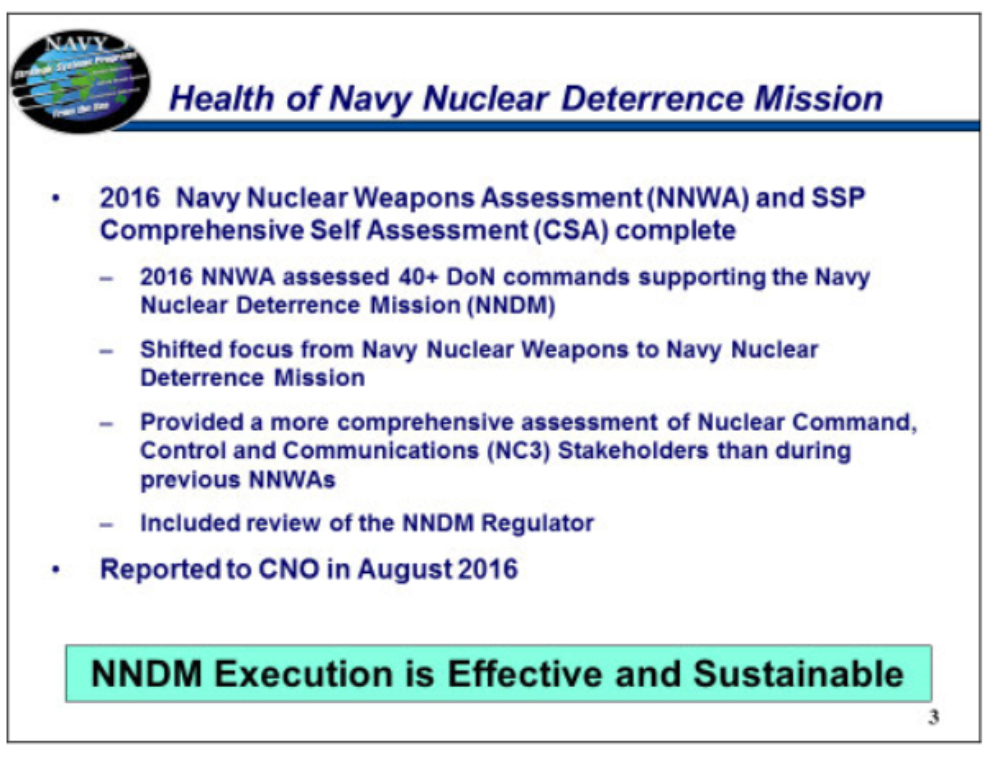
On a bi-annual basis, we conduct a complete assessment. The assessment process begins with us assessing ourselves. After that, we turn that over to the Navy’s nuclear weapons assessment process, which then looks across the entire Navy spectrum. We just completed one this summer, where we looked at over 40 commands across the Navy, ensuring that they were prepared to execute in accordance with the higher requirements. This year, we shifted the focus of that process from Navy nuclear weapons to the Navy nuclear mission.
This brings in a different perspective for organizations such as Naval Supply Command, SPAWAR, or CNIC. It is the most comprehensive assessment that we have completed since we started this process. We took a hard turn on Navy command and control and communications–the NC3 piece and we took a hard look at where we stand, where the plans were moving forward, and most importantly looked to see if we were budgeted properly to ensure that the plans that we are communicating to the outside world are actually funded in the budget and ready to execute.
As we stood up the regulator effort, it was vitally important to me to have a group come in and look at our own process. To examine how we are doing in standing up the regulator effort, determine if we have a broad enough vision, and if we have the aperture set wide enough. We completed that review at the end of June and reported out to the CNO in August of 2016.
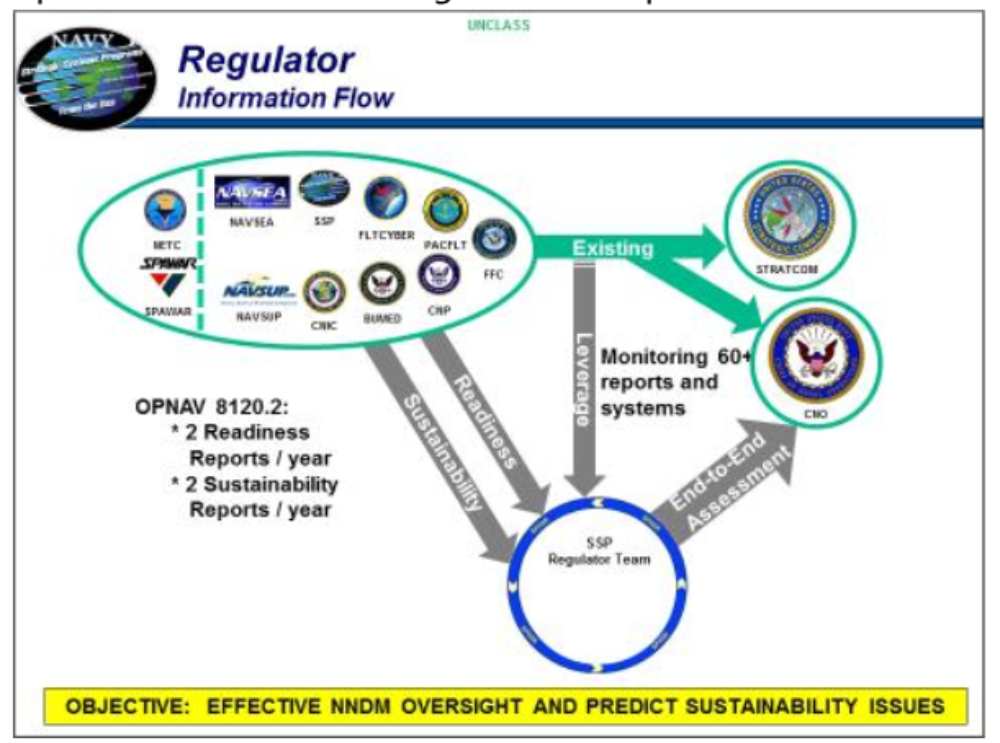
As the regulator, I asked, what are we actually doing? In the simplest terms, I am providing forceful backup to everyone that is doing their job in providing this capability for the nation. What you see in the upper left-hand corner are the commands that I am providing this type of regulatory oversight to. On the left, you see both SPAWAR and NETC. As we took a hard look at the NC3, we recognized that those two commands were not in the original concept, however, we are in the process of including them within our regulatory oversight. As we were standing this up, one of the fundamentals that I discussed with Admiral Greenert was how we are going to do this without taxing those commands in addition to what they are already doing. What we determined is this information flow model shown in the slide. Those arrows represent the existing reports and systems that we now have access to–somewhere in excess of 60. We are reading and monitoring those to help us see what is happening. The only new requirement that we have levied on those commands are four reports per year– two readiness reports and two sustainability reports. The readiness reports are focused in the one to two-year timeframe. The sustainment reports are FYDP-type reports. As you look at requirements, your budget, and your challenges, you can identify if you have the right resources to keep out of a crisis. I recently submitted the first end-to-end assessment to the CNO in October. It is in review now and once he chops off on that, we will push that information out to the commands that were reported on. I am very pleased with where we are going. This provides value to those commands and most importantly, it provides value to the United States Navy and to the larger leadership.
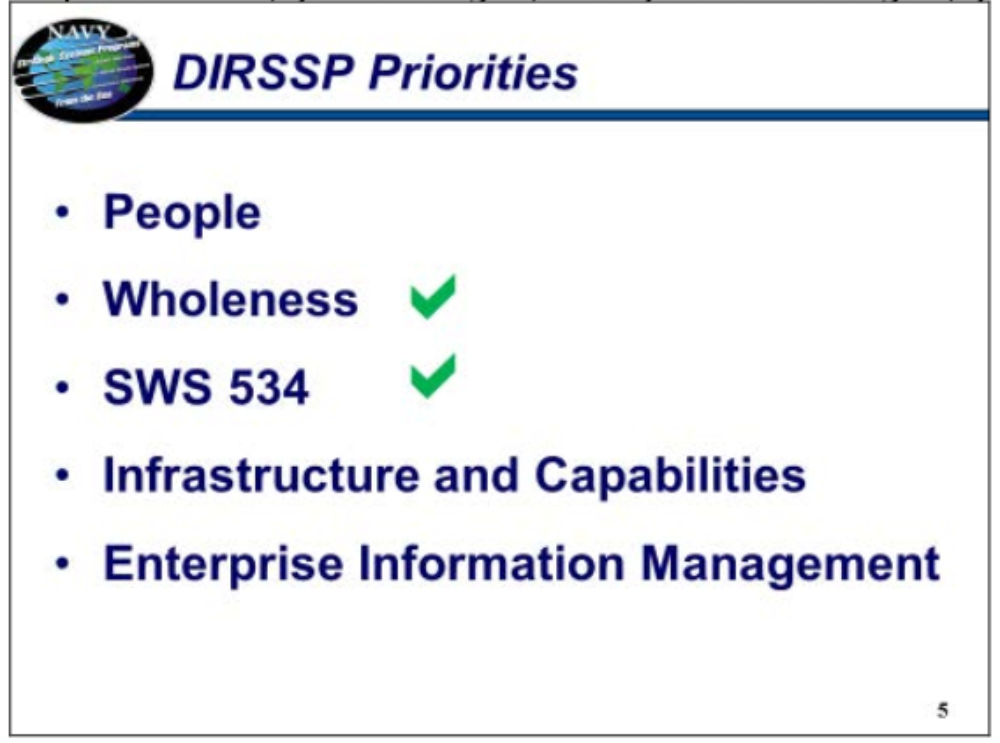
I have been in this job for six and a half years now and I will probably be here for around another one and a half to two years. As I look towards the end of where I am going in the command, I want to ensure my priorities are clearly communicated to the claimancy.
First and foremost, my number one priority is people. I am very happy and proud to say that we are an organization that next month celebrates its 61st anniversary as a program. Not many commands get to do that. I am even more pleased to say that we are not even halfway done. When you look at the Ohio Replacement Program and how long that boat will be in the water, there is a requirement for SSP to be a viable command providing our mission throughout the life of that platform–to 2084. While we can focus on technology, hardware and software, nothing is going to happen if we cannot sustain a personnel model that will attract the talent necessary to execute the program’s mission. I am very focused on the people. Two things in particular: one is growing the next generation. About four years ago we started two leadership institutes within SSP, a mid-level leadership for GS-12s and 13s and a senior-level leadership for GS-14s and 15s, to provide them with the tools necessary to be the workforce that we need them to be through 2084. I am pleased to report that these programs have really gained traction and are providing substantive benefits to the entire workforce.
Most importantly is the requirement that I have to ensure that I turn over the senior leadership in the program. This year we are going to turn over the technical director, chief engineer, the systems engineer, and missile branch engineer. With the exception of the technical director, which is normally a military billet, the rest of those are all senior executive service billets. John Lunney, who is my systems engineer, has 48 years of experience. It is not easy to replace someone like that. We have spent a lot of time working this out. Currently, we are in the process of identifying the right people now. I will have some time with them before I turn over, and we will maintain good stability in the turn over.
My next area of focus is wholeness. Wholeness is my way of describing how I am going to balance my budget appropriations.
As we have come through the life extension effort, I found myself a little bit unbalanced between OMN, OPN, WPN, and R&D. We worked very closely with N-97. We briefed Mr. Stackley and got complete agreement on the way that we would move appropriations in order to ensure that we have a better risk posture going into the next FYDP. That has been approved and I’ve checked that off as a completed goal. Those decisions have been made and those budget executions have been enacted.
My next objective is SWS-524. When we purchased the Trident II D5 at program, we had 533 available missiles. With FCET and DASO testing requirements, 533 missiles will not get us to 2084. There is a requirement for something next. Is it an “E6” missile? Is it “D5 LE2”? We have spent a number of years thinking about this. I have presented to OSD Policy, OSD Acquisition, the Joint Staff, STRATCOM, finally culminating through OPNAV and up to Mr. Stackley. We have begun what I would consider to be the extremely preliminary discussions about what follows Trident II D5. It is not an imminent build, but in this business one of the things I have learned in SSP is you do not wait to start thinking. We have spent a fair amount of time thinking about the acquisition strategy, about the technology necessary, and I now have concurrence from Mr. Stackley on a way forward. We will begin that process here in the next couple of years.
The next objective is infrastructure and capabilities. One of my initiatives in the last couple of years is to continue the work that I have had with industry on where should industry be and what we should expect as the rate structure and how can we adjust those two things to better posture the program going forward. To be specific, I have a large percentage of my business in California where the rate structure is very difficult to maintain. I also have a very capable complex down in Florida where the rate structure is significantly different. As an example, we have been shifting work from California to Florida since I was in California in 1993. This year, I made a major step. We are moving 120 people from Lockheed Martin in Sunnyvale, California to the Cape–strictly because of the cost structure and cost benefits. This goes back to my wholeness discussion with Mr. Stackley. All of these things
begin to tie together, and I will discuss more about the Cape and the capability that we are building later in the presentation. We are going to make a hard push to ensure that we have a strategic plan with our industry partners on where they should be and how that should affect their rate structure.
My final objective is enterprise information management. We are in an organization that is rigorous in our processes and our procedures. As I bring in the new people – my first initiative – where do they go to understand how we operate in SSP? SSP probably has more processes, procedures, instructions, ODs than anybody in the Navy. How do you bring that new engineer in and say, somewhere in this massive paper – if I could even put it in one room – is something you are not supposed to do? How do you have that conversation? As we look towards 2084, we need to look for ways to put that information into a format where it can be searched, adhered to, and executed. We hired Gartner to help us look at this process. One of my last, hopefully beneficial initiatives as the director, is to create an enterprise information management program within SSP that allows us to capture that information and make it available to the workforce.
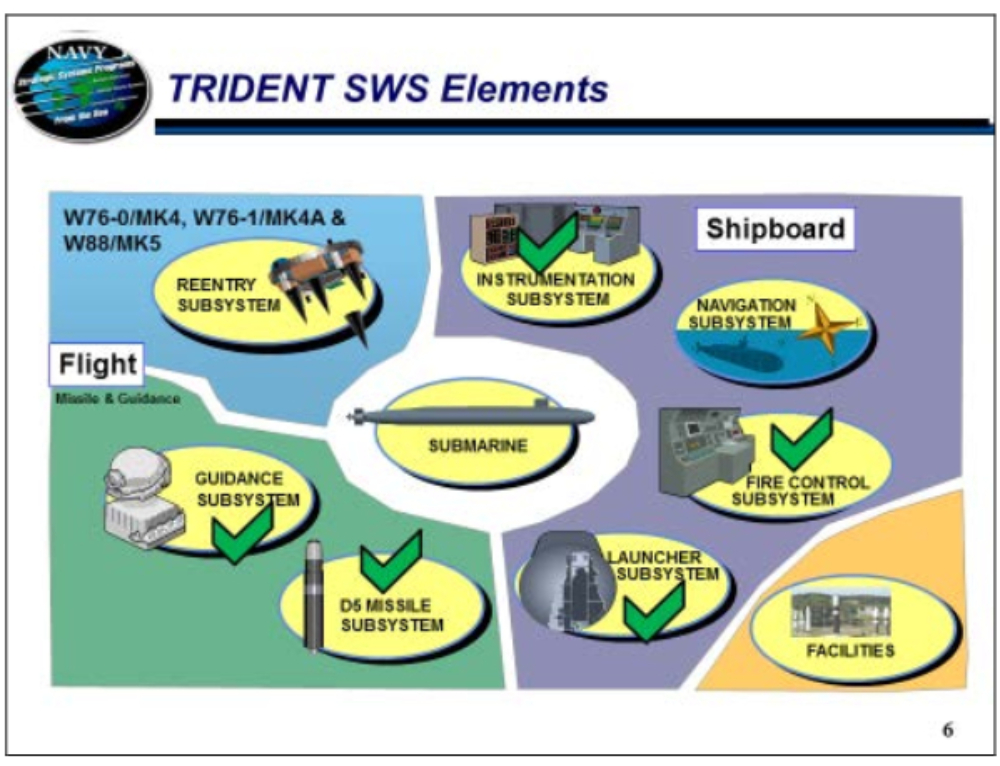
I do not need to remind everyone, of the elements that make up the Trident strategic weapons system. However, what I what like you to note is that I have placed checks on some of those ball circles. Guidance and missiles, I checked because the new guidance system as well as the four missile electronics packages that are part of our life extension efforts have been certified. Launcher subsystem and its transition in architecture, as well as its transition to COTS hardware and software, has been executed. Fire control has been executed. Instrumentation has been executed. And most importantly, it is deployed today on the Ohio-class submarines going to sea, certified to launch nuclear capable missiles.
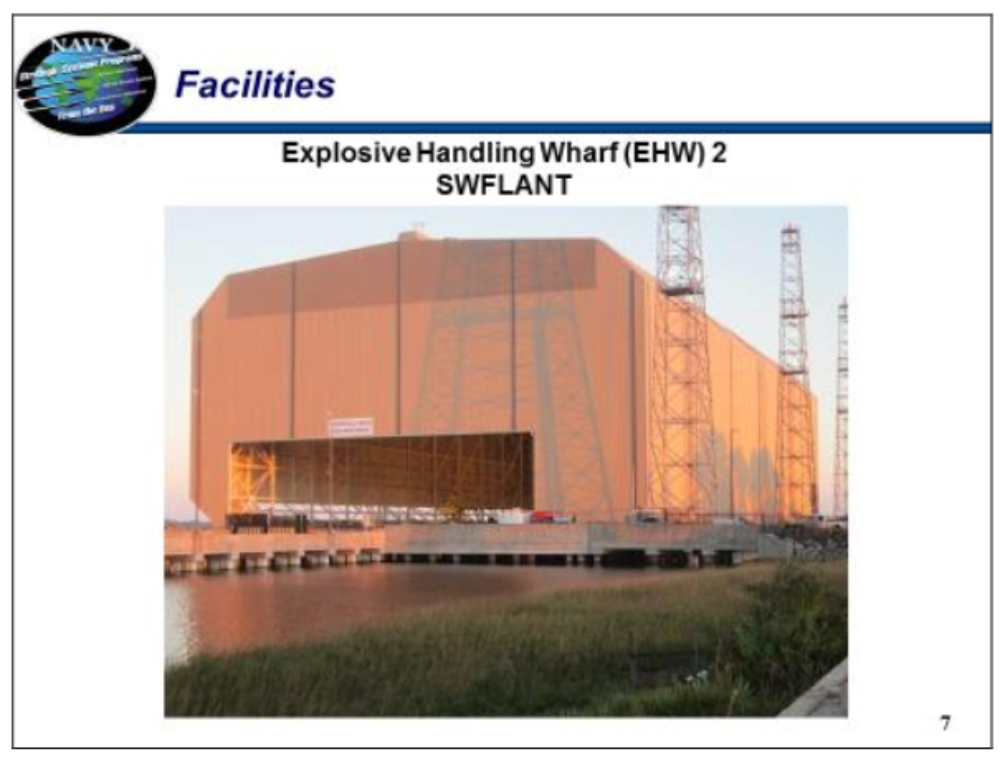
Let me spend a moment and talk about facilities. When I retire, NAVFAC should give me an honorary CEC badge. I have spent more time as an engineering duty officer building buildings, than I do building hardware that flies.
Explosive Handling Wharf Number 2 at SWFLANT. I did not build this – I just had to get it back. Originally, this program was supposed to be about two years. It ended up being just over four. The problem is when we actually started the complete refurbishment of this EHW, we identified a significant environmental issue with lead paint. As you sometimes see in houses where you have to fumigate the house and have to cover it, we had to cover that and take it down to its structural members, sand blast it, and then put it back together. As you can imagine, I have huge cranes there to lift ordnance and other assets. They sat on the rails for more than four years. Getting those things back to certification levels was not an insignificant issue. It is now operational and supporting the fleet. However, as I do that, I can look just to the left of this picture to EHW-1 and we will need do the exact same thing. However, we will use our lessons learned and hopefully it will not be a four-year process.
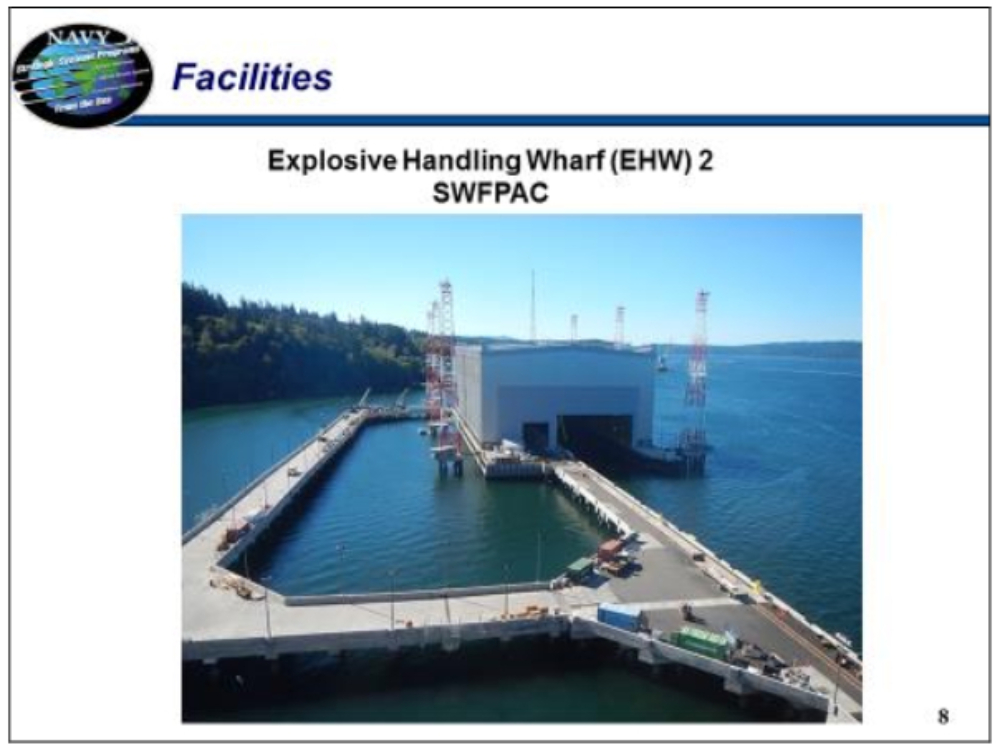
This one we did build. This is the latest picture from Explosive Handling Wharf Number 2 at SWFPAC, a major Navy investment in MILCON to give us the second EHW capability in the Pacific. It is moving right along. We had a couple of issues in construction, in timing, with moving barges and cranes, but we are in the endgame, inside the red zone now. It is always hard to get across the goal line with last minute issues, but we are working hard with the contractors, and most importantly with the fleet, as we will need a submarine to do the proofing. All of that is in the final discussion points.
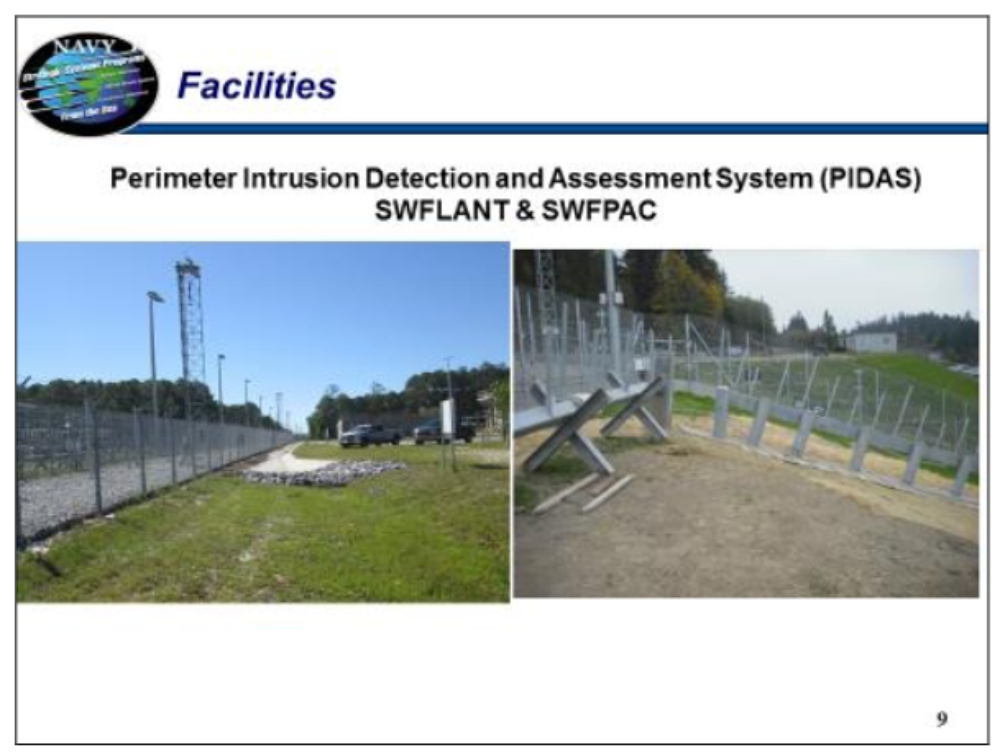
The next facility upgrade I will discuss is PIDAS or Perimeter Intrusion Detection and Assessment System. Our investment in nuclear weapons safety and security over the years has been huge. The PIDAS fence line at both SWFLANT and at SWFPAC totally encompasses the waterfront restricted area. Construction is complete and we will spend this year installing and certifying the sensors. At the beginning of 2018 we will certify that entire program as good to go, and then the entire waterfront restricted area of maintenance and operations support area will be within a nuclear weapons restricted area.
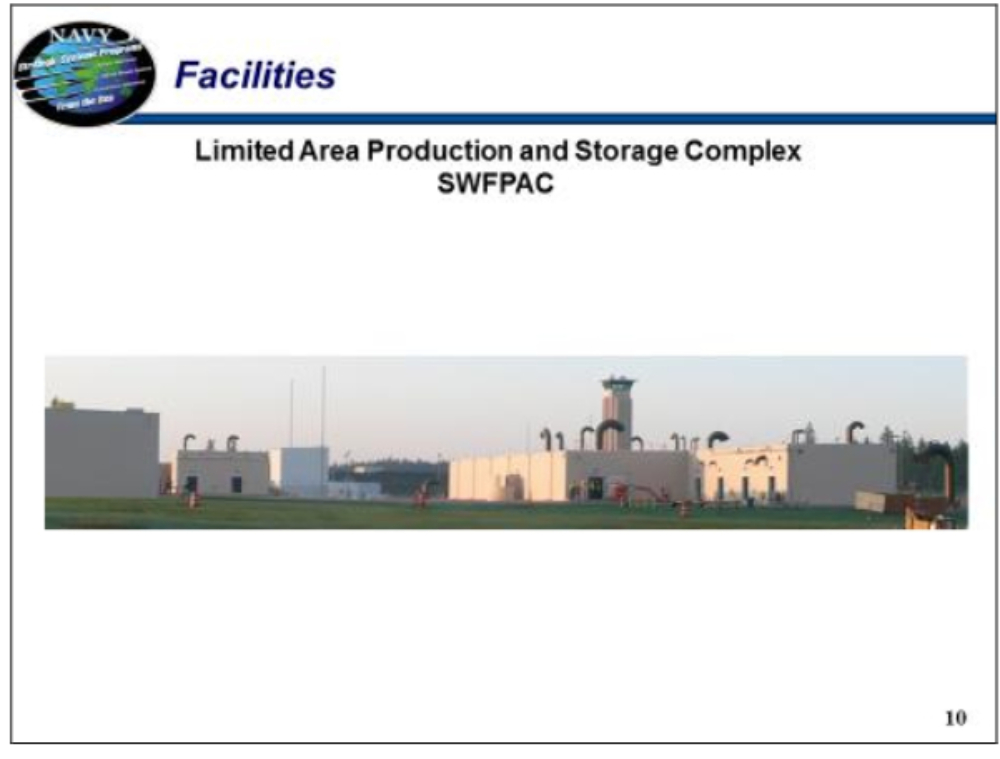
This is our Limited Area Storage Complex at SWFPAC. If you look at that picture, you should say to yourself, that does not look that hard. What you do not see, under-ground, is a super Walmart-sized complex, and that’s exactly the way it’s supposed to be. You do not see where the weapons are actually stored and processed. So underneath those few visible buildings is a complex, probably the most advanced and capable that this nation has built in the last couple of decades. This facility is now certified and fully operational at SWFPAC.
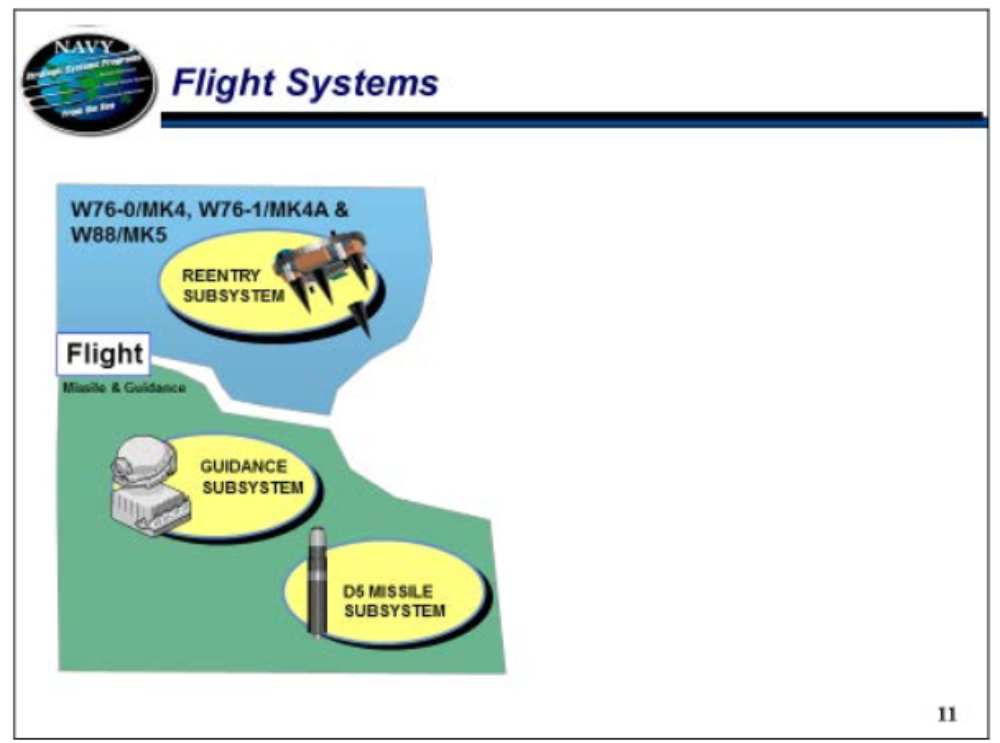
I will now address flight hardware. I will start in the upper left-hand corner of the slide. I was down at Pantex a couple of months ago with the Secretary of Energy and the Chairman of the House Armed Services Committee. We were there to celebrate the opening of a new building, but we also celebrated the fact that the 76-1 is now in excess of about 78 percent complete in her production run. We are right on schedule. We will complete that in fiscal 2018. That transitions right into the W-88 Mark V Alt 370 effort, which is our new arming, fusing and firing circuit, and that is right on schedule to begin initial operating capability in fiscal 2019. By 2023 both re-entry bodies that the Trident II can carry will have had life extension efforts and will be good through the early 2040s as a point in time. So we are very well supported by NNSA. They are just knocking it out down at Pantex, and so we went down there to celebrate that.
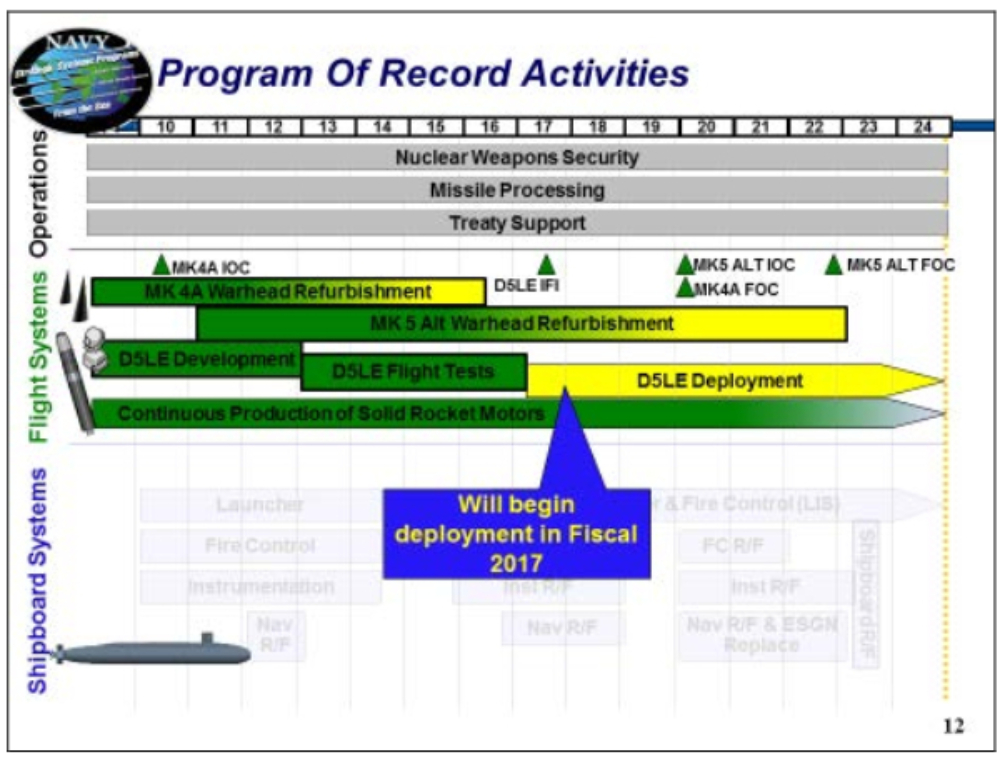
In terms of guidance and missiles, the slide shows the schedule that we set out. I will focus on the middle rows as the flight systems. We are tracking right to plan. We will begin deployment this fiscal year of our life extension efforts, both guidance and missile electronics. You see that is the D5 IFI triangle up there. We are ready to support that.
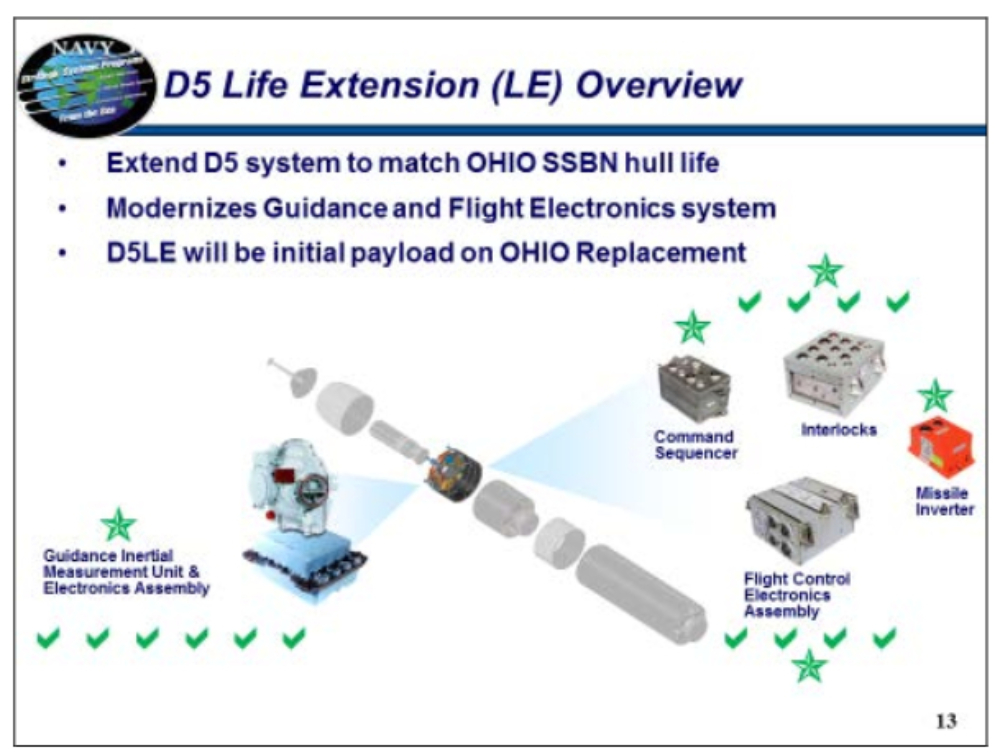
What you see here are the stars that represent certification. You also see the checks that represent the flights that we have actually flown successfully with this hardware in various configurations. Every flight fully met its flight objectives. We consider both the EA and the IMU, which make up the Mark VI Mod 1 as well as the four missile electronics packages: command sequencer, interlocks, flight controls, and inverters as certified and ready for deployment.
Again, this will go on Ohio. We will put this out on Ohio and then it will transition to Ohio Replacement. This singles up all our training, all our logistics, all our documentation. It is a very cost- effective method to move into the next platform.

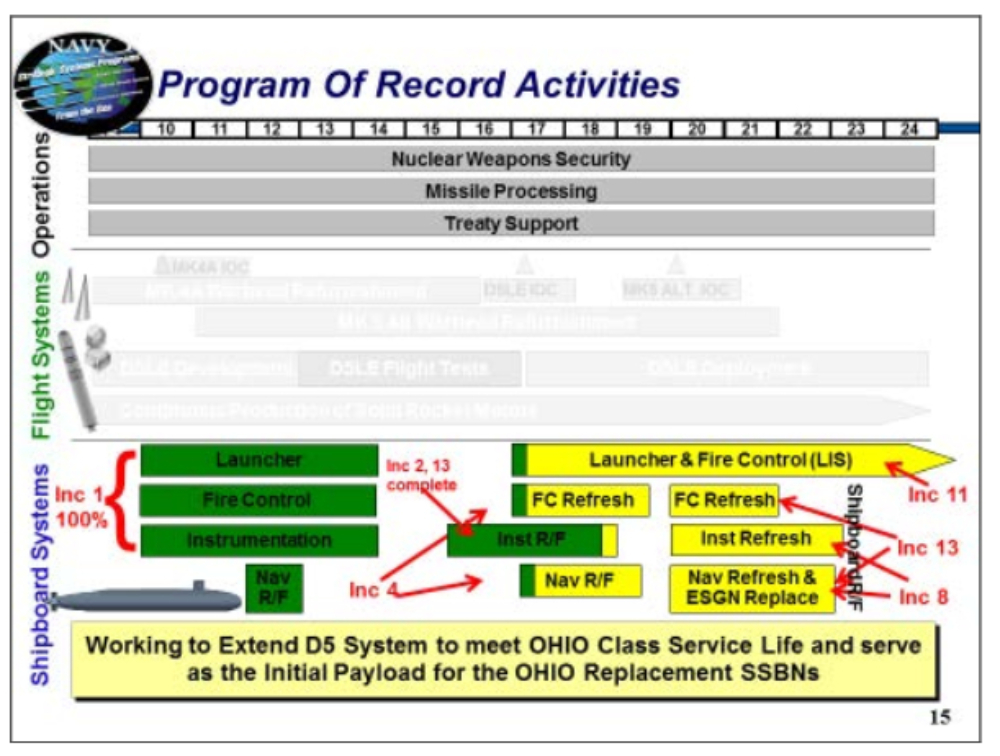
Now, we will talk about shipboard systems. Looking at the bottom section, everything that is totally solid is complete. At SSP we use the term Shipboard Systems Integrations Increments – roughly equivalent to the NAVSEA concept of ARCI. This is the work we are doing on the shipboard portion of the strategic weapons system. Unfortunately, they do not go Increment 1, 2, 3 4 – in chronological order – for a number of reasons. That said, INC
1 was the initial effort to a different architecture with COTS hardware and software. That effort has been completed on both the
U.S. and UK boats. From that, we leverage into the next refresh cycle. For INC 2, which is an instrumentation refresh, we have completed 13 of the 14 boats. The only reason we have not completed the 14th boat is we just have not had access to her.
The last remaining shipboard system is navigation. The manner in which we will refresh navigation is in two major increments. Increment 4 refreshes the cabinets and electronics. INC 8 actually gets to the ESGNs and the instruments themselves and replaces the ESGNs. INC 4 is perhaps the one that I have been focused on the most over the past year. In INC 4 we are actually on USS Maryland now doing the first install of INC 4. We are 45 percent complete and staying on schedule. Once we complete Maryland, we will have a refresh for the rest of the U.S. and UK boats.
INC 8, is the actual ESGN replacement, and I will discuss that in greater detail in a moment. That is the last major effort that we will complete, and then I will report to Admiral Goggins and Admiral Jabaley that we are ready to support the SWS installations in the Ohio Replacement Program.
The launcher and fire control and LIS, that’s Laser Initiation System on the launcher gas generators, that’s called Increment 11. That work is on track. We have actually done one trial install, which must be done in an empty tube. We are moving away from electrical initiators to laser initiators. This is important because as we get to Ohio Replacement in the future, it will allow us to do additional work on the tube without removing the missile. That allows us the opportunity to give the boat back to the operators instead of requiring a missile pull every time we need to do certain types of work on the tube itself.
Increment 13 is the final refresh and with that, I consider all electronics and software ready to go for Ohio Replacement.
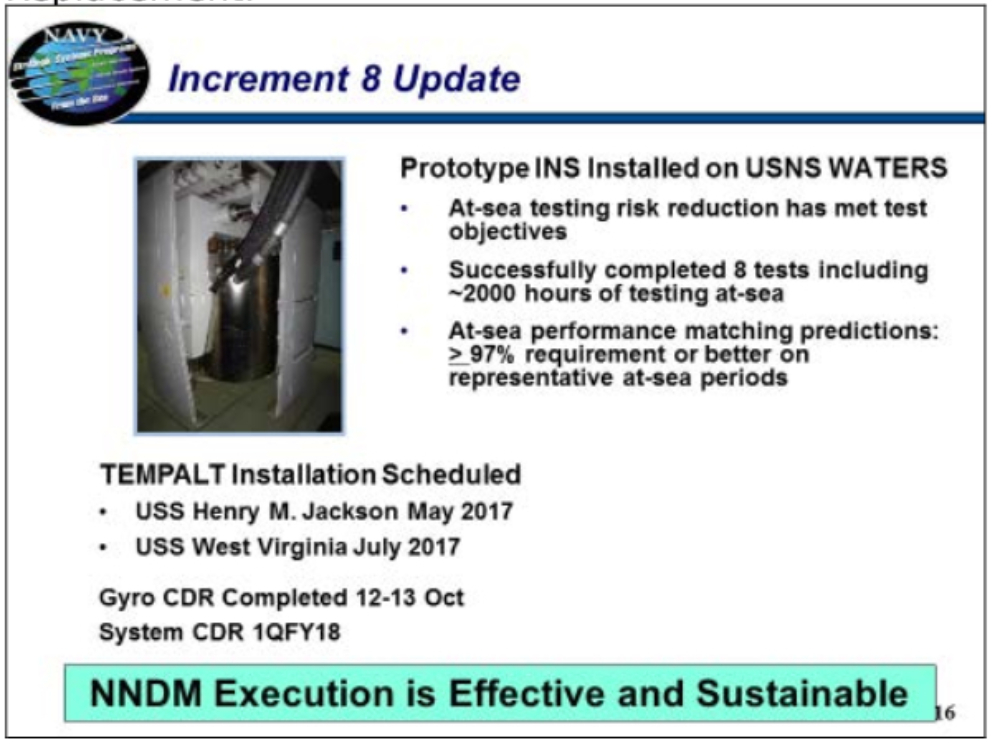
Now I would like to discuss increment 8 in a little more detail. It is a major effort replacing the ESGNs and strategic navigators. We have been working from labs to prototypes. Last January (2016) we installed a prototype INS on USNS Waters, our test instrumentation ship. We have been doing at-sea testing since then. We have accumulated over 2,000 hours of at-sea testing. It has been a very measured process and supports what we believe we should be seeing at this point.
We have two TEMPALT installs that we will complete this year on Henry M. Jackson in May and on West Virginia in July. This will include putting the third binnacle on the bedplate in the navigation center, and we will start putting a prototype at-sea, and we’ll monitor it against the performance of the two ESGNs. We will do this for over a year, gathering data and gaining additional confidence.
We will then move towards the actual installation with the operational fleet. The gyro critical design review (CDR) was complete and the system CDR is right on-track and we are moving towards that. We moved the system CDR out a little farther than we normally would because we wanted to come into system CDR with this data and give us the greatest confidence that when we stamp CDRs complete, we will be ready to go into production. This is a very complicated instrument to replace, but it is an absolute necessity as we move to Ohio Replacement.
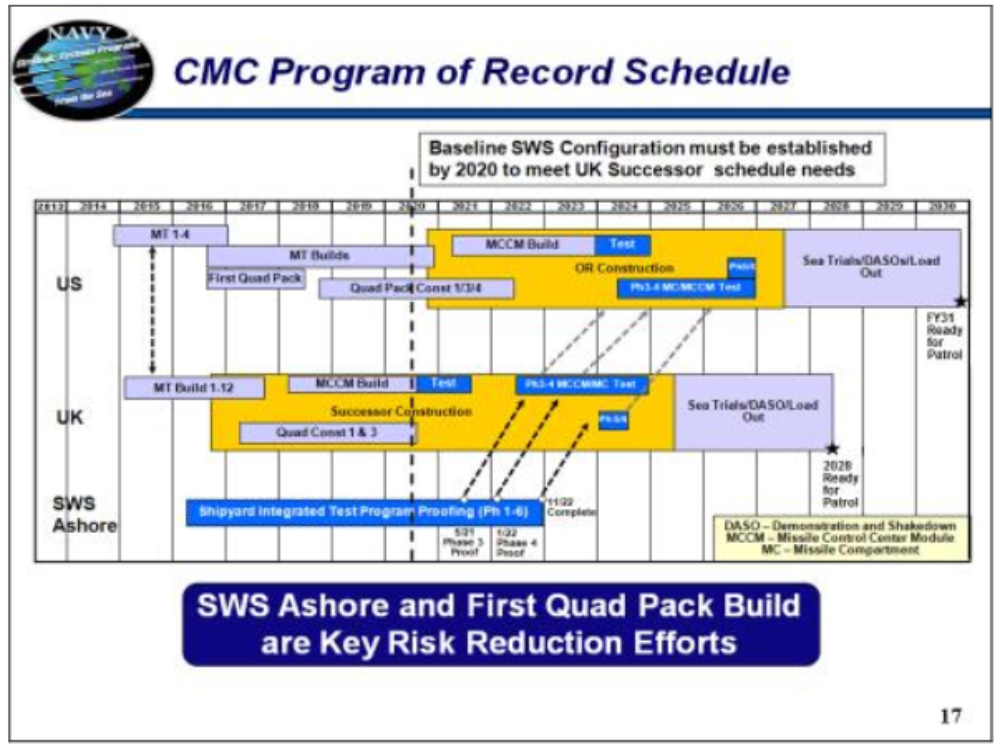
Now we will look at the submarine and the Common Missile Compartment. Our concept to reduce risk not only for the U.S. but for the United Kingdom as we are partnered on a Common Missile Compartment. I would now like to discuss SWS Ashore – what that facility actually is and where we stand with it. We will do all the integrated test procedures and proofing in order to execute the Shipyard Integrated Test Programs at both Electric Boat and in Barrow in the United Kingdom.
We will push those procedures to the UK as their schedule is laid out and further refine them there. Likewise, any changes there, we will move to the U.S. program as we come through the certification at Electric Boat, the major risk reduction, in order to reduce construction timelines.
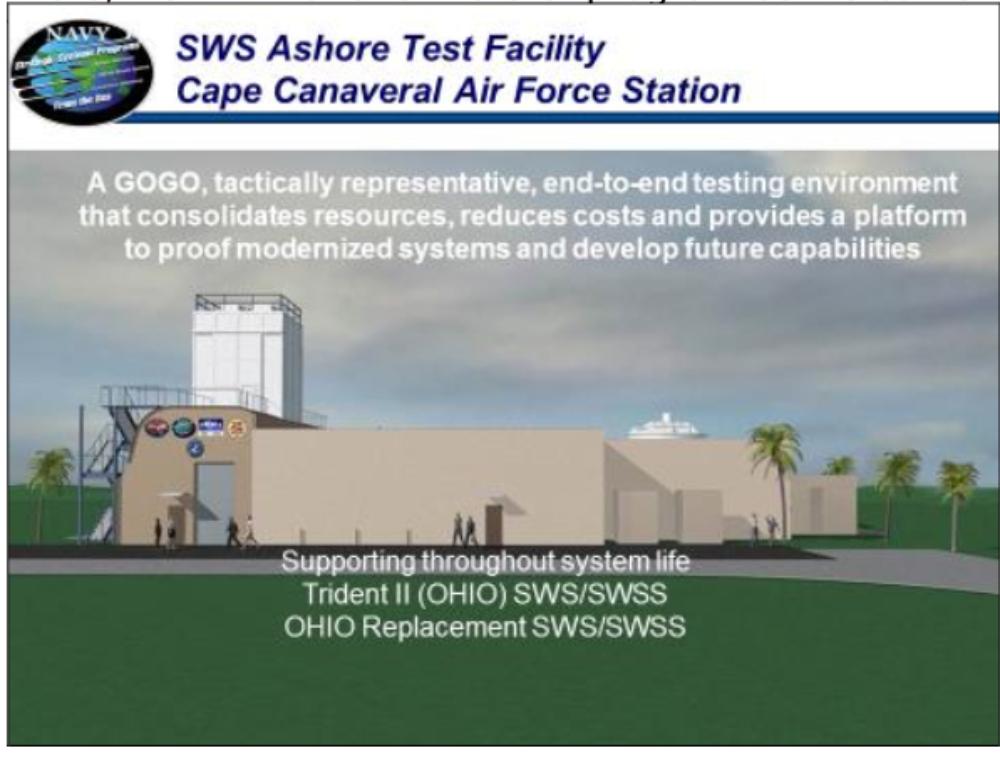
Our vision for SWS Ashore at Cape Canaveral is not only how we could use this to get the Ohio Replacement Program through the shipyard, with a higher probability of success, but also, since we are only building 12 boats for Ohio Replacement, this facility becomes our “13th and 14th ” available boats. We will not have the luxury we enjoyed in Ohio where we always had two boats in availability where we could complete installations and not affect the operators. When we go to 12 boats, every boat is pretty much fully programmed for its entire life. We cannot put an alteration on a boat and then just say, we need to take that off or modify it again. It would be a major impact to Ao and a major impact on the operations of those assets. So SWS Ashore not only gets us through the shipyard, but it becomes our final certification facility before we go and install and potentially negatively impact the operational forces.
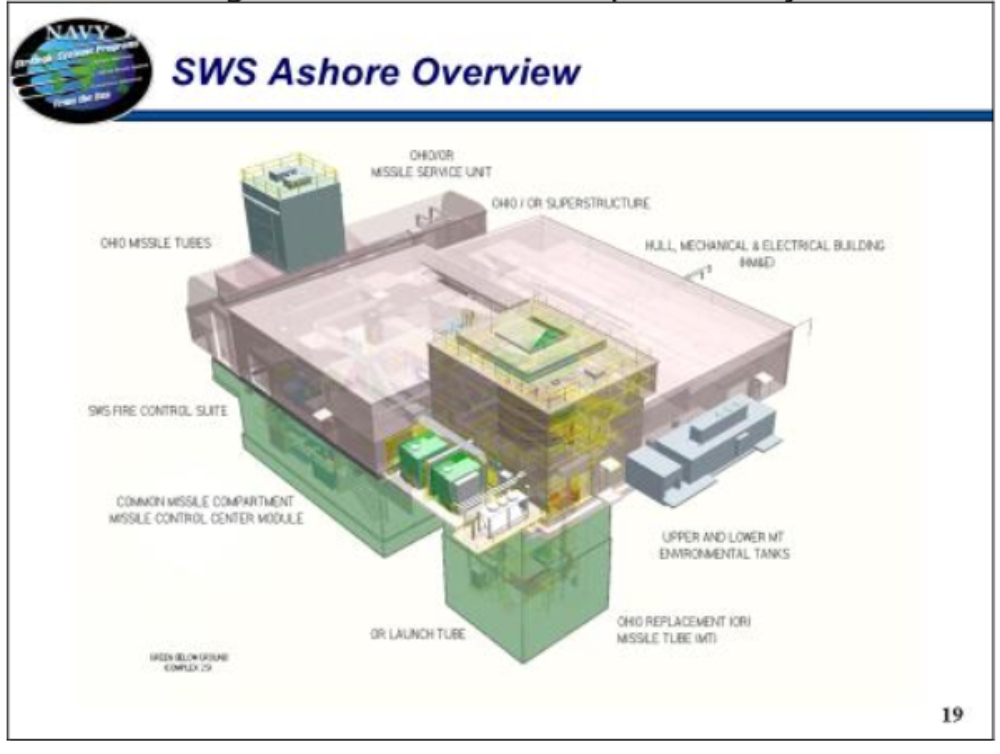
This is a high-level diagram of SWS Ashore. We started with the former Launch Complex 25 – the launch complex we used during Polaris launches. It was vacant and filled with water. We developed a concept of how we could take that infrastructure – a significant investment if we had to start from scratch – and leverage it to build this complex around it. In the upper left, is what is called the Ohio side. Working collaboratively with Electric Boat and NAVSEA; WSSELBEF, that was at Electric Boat, we cut it in half, floated it down to Florida on barges, and reconstructed the two Ohio-class missile tubes that were in the EB facility, and installed them on the upper left-hand side, the facility in this diagram. On the lower right-hand side is the Ohio Replacement tube that will be installed in the facility. We will have environmental chambers on the upper and lower aspects of that missile tube which will allow us to certify the various operational patrol areas and the impacts of temperature on the missile and missile tube.
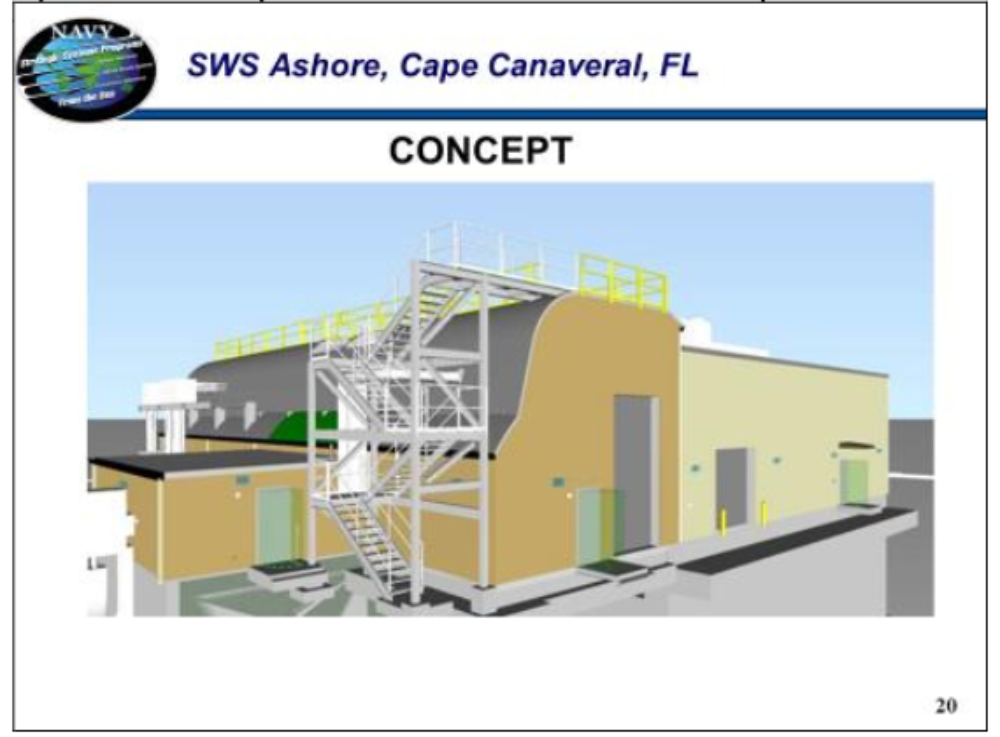
This was the concept of the facility.

That’s the building as it is today. I will walk you through it.

We spent the last year fit testing the various pieces of support equipment, installing the hatches, and ensuring that with those two tubes installed in the Ohio side of the building were ready to support Ohio as we move forward. All of this has been, again, risk reduction to ensure that when we work on the Ohio Replacement side, we are as high on the learning curve as we can go.
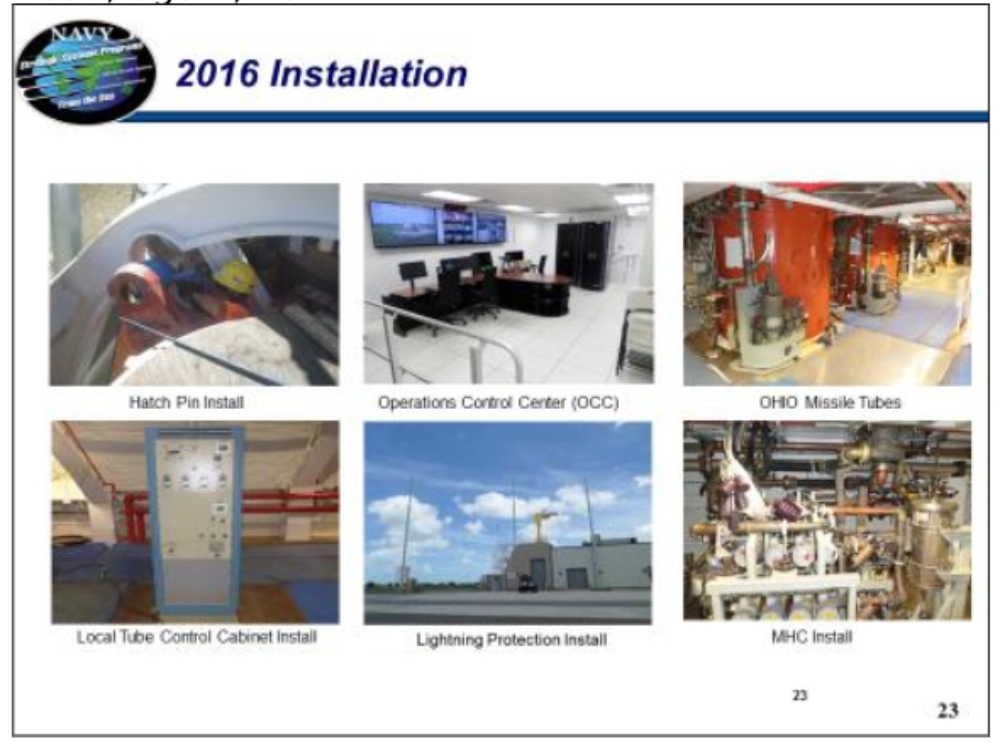
The operations control center in the middle upper row of pictures is actually the control center. We will be using this as a live test facility, as well as certification facility. It will have a Missile Control Center Module. The MCCM that will be on the Ohio Replacement will be installed between the two sides. As we operate the entire facility, opening hatches and the like, we will control those aspects–from a safety standpoint–from the operations control center. Also shown is the lightning protection that is installed and the completely refurbished Ohio missile tubes.
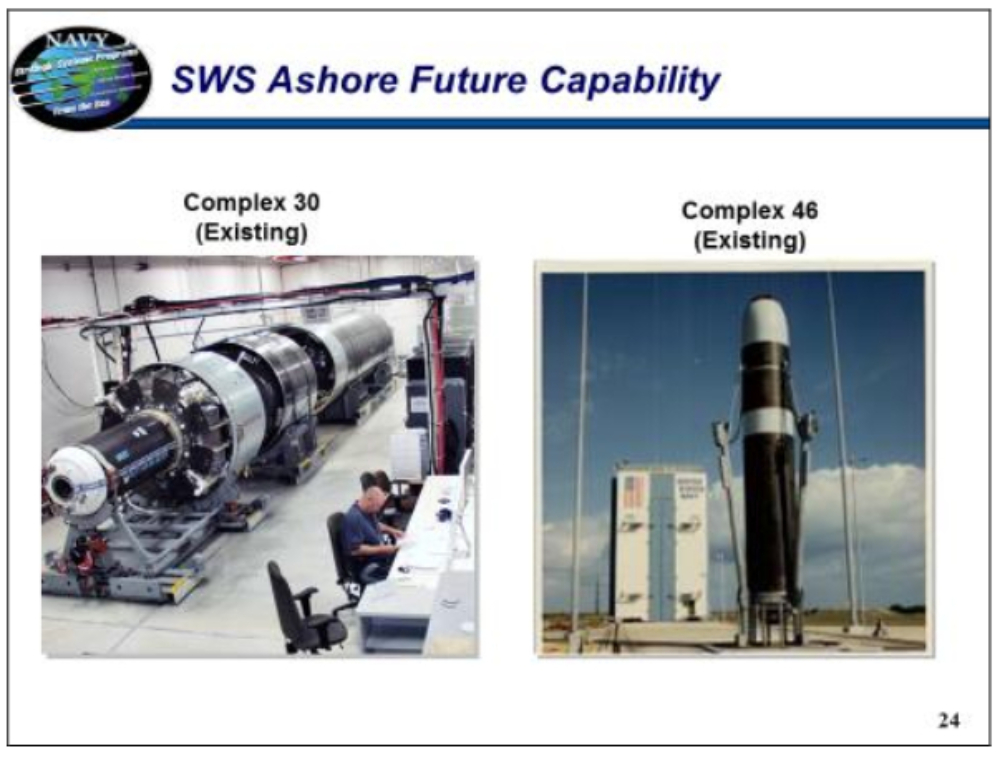
As we move forward into the remainder of the program supporting to 2084, the idea is to utilize Complex 30, which is an existing facility at the Cape. This shows a horizontal inert missile where we do a lot of missile testing. The thought is that we could pull that missile integration into SWS Ashore, especially, as we are moving with the next 534 program. Of course, we have always maintained Complex 46, which is where we conduct our initial shore-based testing. We are looking at how that could tie into SWS Ashore.
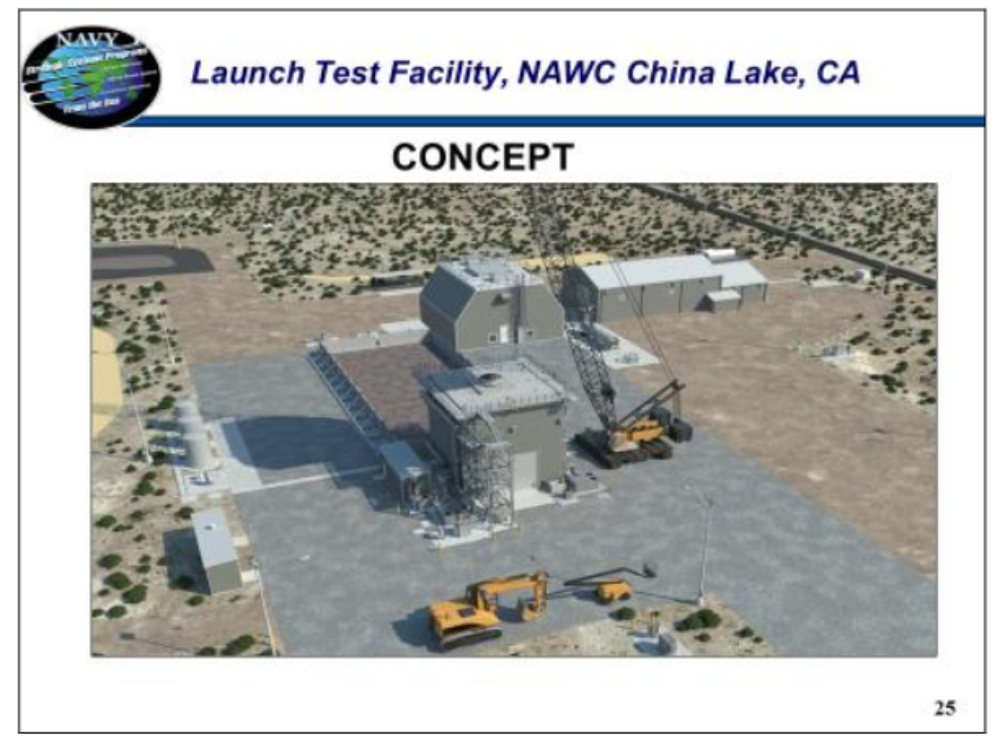
The other major infrastructure piece that we have been working on for the last number of years is the launch test facility at China Lake, California. We stood this facility up because the entire infrastructure that builds launch tubes has been shut down and dormant for many years. This launch test facility was the concept we developed. Here, we will perform launch shots of an inert shape.
We considered going back to the old concept–the sky catch at Hunter’s Point – that we had used during the original D5 program. We found that to be a significant cost investment, so we are utilizing this as a means and a method to reduce cost. This slide shows the concept.
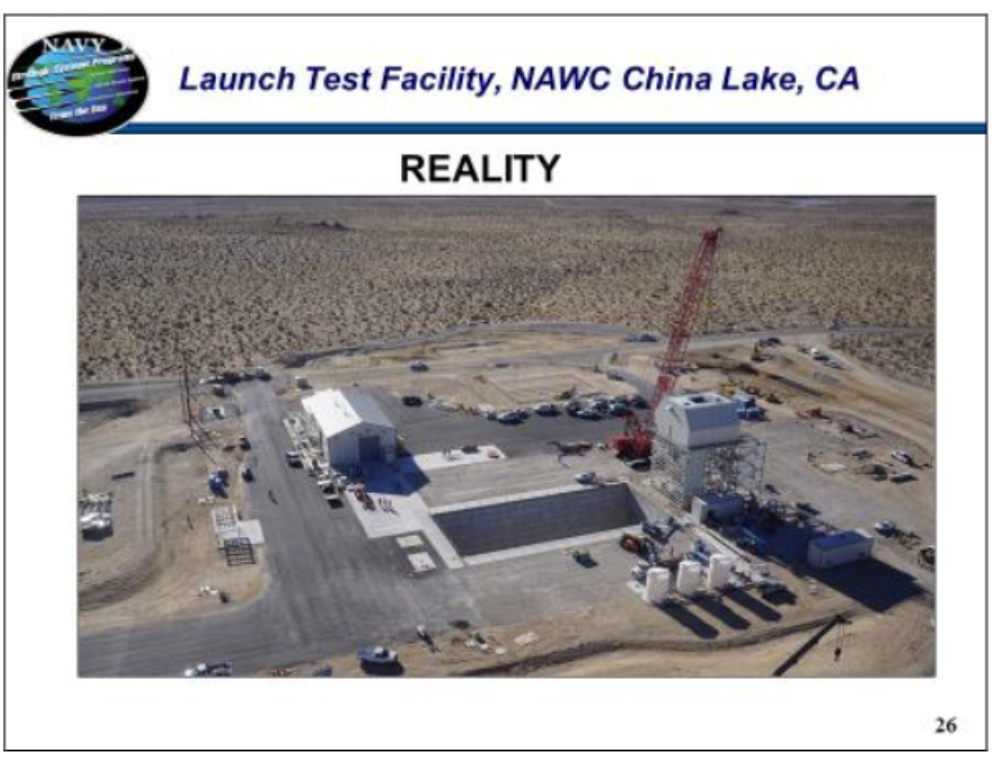
And this shows the facility as it is today. To the right, shows the vertical stands where we have a launch tube that is grouted in. We will launch inert shapes that will essentially pop out of the infrastructure and land in what is probably the largest gravel pit that has ever been constructed. We will refurbish the shapes after each launch and keep launching them to ensure that the design, materials, and all the other parameters are right, because the first time the Ohio replacement and Vanguard successor programs plan to launch is from a submarine.
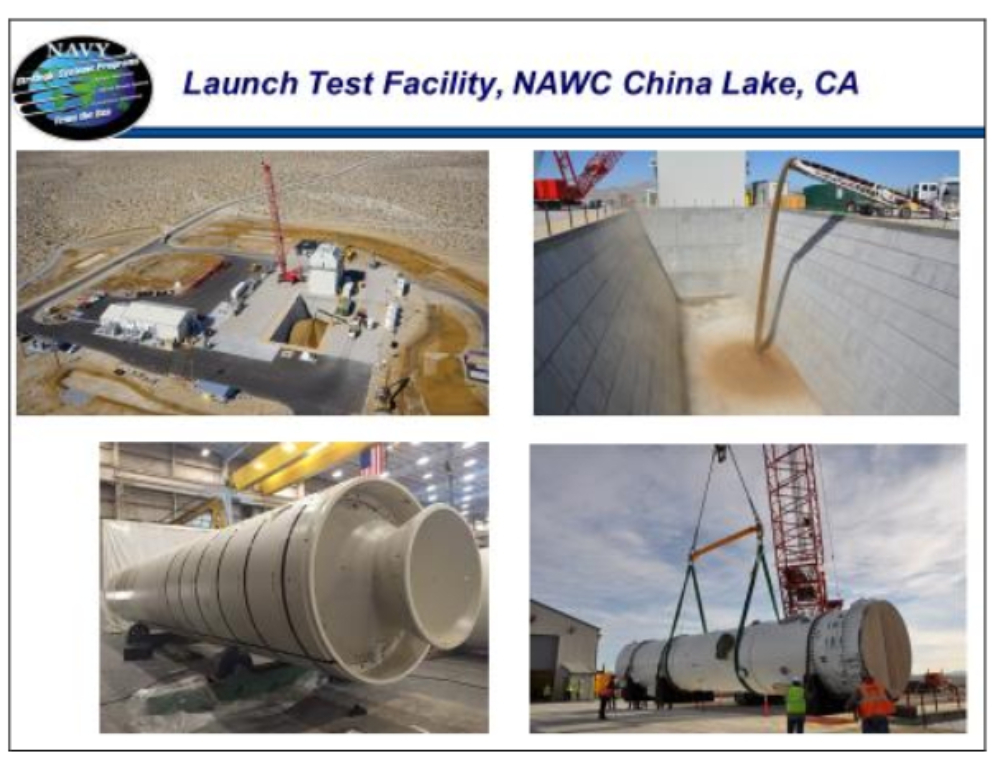
This shows the actual filling of the gravel pit, in the upper two pictures. The bottom left-hand picture is one of four shapes. It is a cement-filled shape that matches the physical parameters of a Trident II D5 exactly. It is robust so that when it lands in the gravel pit it is not terminally damaged. We bring it out, we refurbish it, and then we are ready to launch again. The bottom right-hand is the actual launch tube that is now fully installed, grouted, certified, and in the process of being instrumented. Just after the first of the year, we will begin launching these shapes from that test facility.
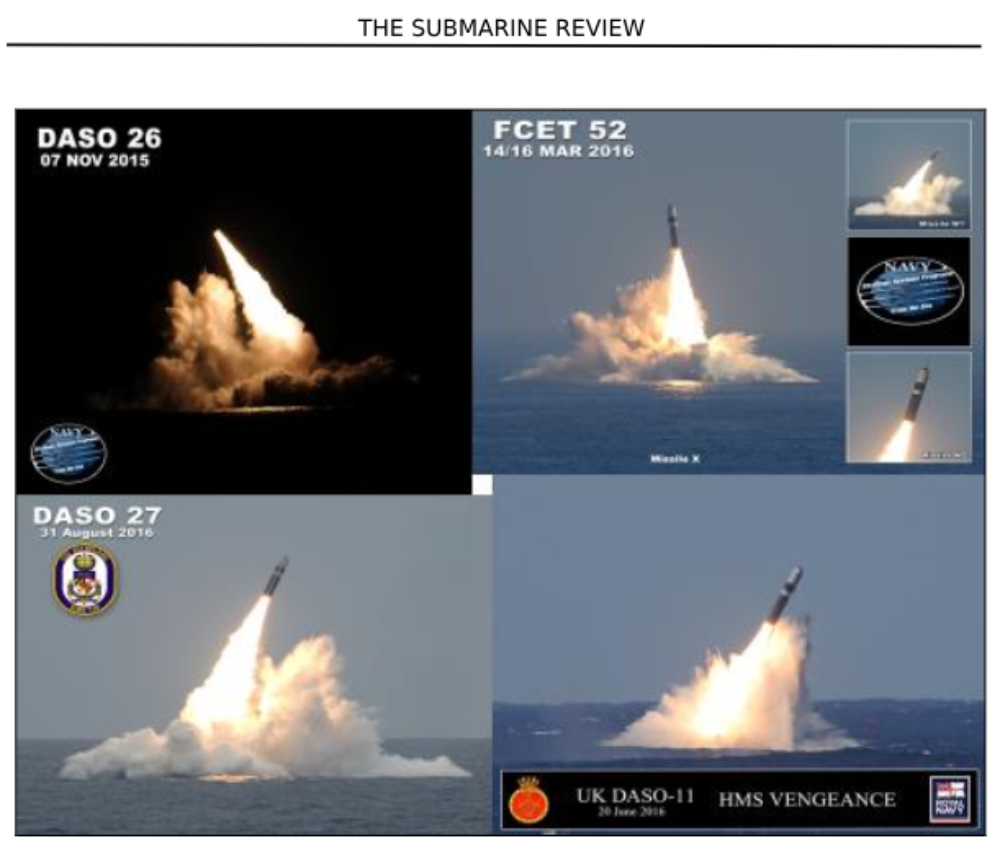
If that was not enough to be doing, over the last year we have had numerous launches. We had DASO-26 in November of 2015. That was a pretty exciting launch as we lit up the Internet as the UFO that attacked the West Coast. We then moved from DASO- 26 to FCET-52 – a very successful three-missile launch from USS West Virginia. Then, under the Polaris-Sales Agreement, we supported HMS Vengeance in June off of Florida with her launch – DASO-10. And then finally, in August, USS Maryland, again off of Florida, conducted DASO-27. We put a lot of hardware in the sky over the last year. We have a four-missile FCET coming up shortly in the next calendar year and another DASO next summer on the West Coast. There is a lot going on in the program. I would hope that from this report you would leave with some confidence that we are right on track, right on budget, and meeting all our technical parameters in support of the Ohio Replacement Program, and the existing support of the Ohio Program.

